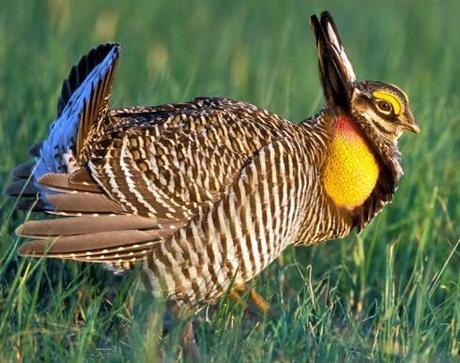Cross-posted from the AP
This week, the U.S. Fish and Wildlife Service held its final public hearings on a proposal to list the prairie chicken as threatened under the Endangered Species Act. This comes after decades of population declines that experts blame, in part, on the expansion of farms, ranches and energy industry operations across the Southwest and other states.

Brady Stout, who grew up in Emporia, but hunted prairie chickens on his grandfather’s land in Bazar, recalls seeing waves of 200 and 300 birds flying into the fields when he was out hunting.
Today, he runs a ranching operation on that same land and the prairie chickens are nonexistent.“Usually, I will see a handful through the winter, but this year I haven’t seen any,” Stout said. “There are lots of theories why the birds disappeared, but I don’t know if anyone really knows why.”
Stout is unsure whether the birds should be put on an endangered list, but noted that Kansas still has a long hunting season for them. More than half of the about 37,200 short-flight birds counted last year were spotted in Kansas. Texas banned such hunting in 2009 and Colorado already has listed the lesser prairie chicken as threatened. They’re also found in portions of New Mexico and Oklahoma.
During the public hearings, oil, gas and wind energy producers are working to persuade federal wildlife officials not to enact protections for the lesser prairie chicken, a move that could force them to halt or significantly alter their operations to protect the species’ dwindling grassland habitat.
Even as wildlife advocates make their case, companies have been developing habitat-conservation plans they hope will prevent the agency from taking such action. A similar strategy worked last year in Texas and New Mexico when the federal government considered protections for the dunes sagebrush lizard.
A federal listing would “make life more complicated for producers,” said Alex Mills, president of Texas Alliance of Energy Producers. “I am optimistic that our conservation efforts toward the bird and the habitat can be effective.”
Spring mating season is usually the only time people can see lesser prairie chickens out and about as males sing and strut across grasslands, displaying brilliant yellow-orange eye combs and puffing out their reddish-purple air sacs to attract females. But with the species’ numbers down about 80 percent since the early 1960s, spotting them even during courtship has become increasingly difficult.
Governors of these five states last month issued a statement opposing federal protections for the bird, noting voluntary conservation efforts by their states and commitments from industry leaders and landowners to address the issue.
But advocates for the lesser prairie chicken are concerned such plans would not be enforceable.
“That’s going to be a major test when it comes to the chicken,” said Jay Lininger of the Center for Biological Diversity, who calls the species a bellwether for America’s prairies and does much to regulate insect populations. “Each state is going to do its level best to avoid a federal listing. However, whether those agreements will avert extinction remains to be seen.”
The chickens, which have feathered feet and a stout build, need large tracts of relatively intact native grasslands and prairies to thrive. But such habitats are being wiped out as wind turbines, oil derricks, ranches and farms are added.
Wind energy companies that expect to develop farms across the chickens’ habitat began work on habitat-conservation plans three years ago and hope to have one finalized in March, said John Anderson, director of siting policy for the American Wind Energy Association. He declined to share details of the plan.
“We really want to try to be as proactive as possible to show it’s not necessary to go forward with the final listing,” Anderson said.
The Environmental Defense Fund also is helping by setting up voluntary habitat exchanges with ranchers and farmers to create and maintain vital spaces for the chicken. Energy companies and other developers pay landowners to mitigate land use to meet their obligations to offset wildlife impacts.
Lesli Gray with the federal wildlife service in Dallas said the agency is encouraging all conservation planning to help the prairie chicken, but would not say whether this would influence the agency’s final decision, expected this fall. However, landowners and industry who have a wildlife-management plan in place would avoid further restrictions if the lesser prairie chicken moves from candidate status to threatened.
“Those are all good things,” she said. “We look forward to getting that information.”
The third of four public hearings by the wildlife service was scheduled for Monday night in Lubbock, Texas. One in Roswell, N.M., was set for Tuesday.

